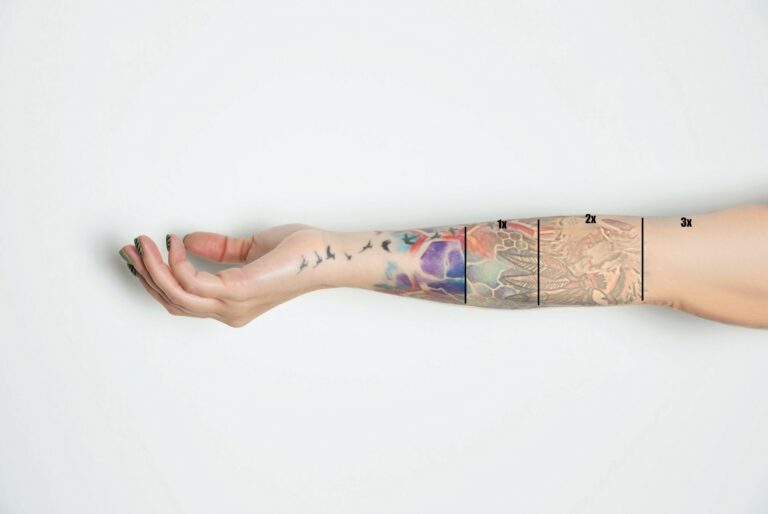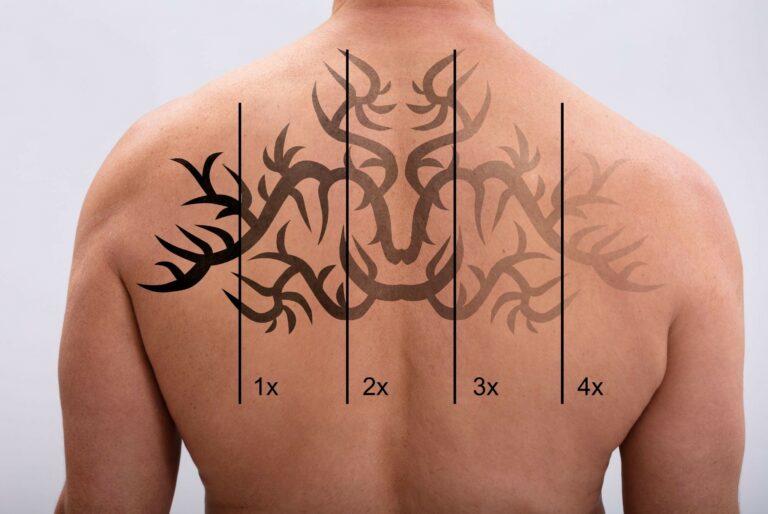Tattoo Removal: Post-Treatment Care Instructions
Introduction
Tattoos have become a popular form of self-expression; however, sometimes people regret their decision to get one. Fortunately, with the advancement in technology, tattoos can now be removed through laser treatment.
Laser tattoo removal is a safe and effective way to remove unwanted tattoos. It uses high-energy pulses of laser light to break up the ink particles in the skin.
While the tattoo removal process itself is important, what you do after your treatment is equally important. Proper post-treatment care can help ensure that your skin heals as quickly as possible and that you achieve optimal results.
Brief Overview of the Tattoo Removal Process
When you undergo laser tattoo removal, a specialized laser is used to target the ink in your skin. As the laser passes over your skin, it breaks up the ink particles into tiny fragments that are then absorbed by your immune system and eliminated from your body over time.
The number of treatments required will depend on various factors such as the size and color density of the tattoo, its location on the body, the individual’s healing capability, etc. Multiple treatments are usually required for complete tattoo fading/removal. Laser tattoo removal is generally considered safe when performed by a qualified specialist who follows proper safety procedures during treatment.
Importance of Post-Treatment Care Instructions
Post-treatment care instructions are essential for achieving optimal results after the laser tattoo removal procedure. Proper care can help prevent infections or complications while allowing for faster healing times with less pain. It is important to follow all instructions carefully provided by a specialist who performs laser treatment including coverings, cleaning routine, moisturizing routine, and avoiding direct exposure to sunlight & heat, etc.
Failure to follow these instructions may result in complications such as infection or damage to surrounding tissue which may lead to increased discomfort during the recovery process or long-term scarring. Proper post-treatment care can help minimize risks and ensure that you get the best results possible from your laser tattoo removal treatment.
Immediate Post-Treatment Care
If you have just undergone a tattoo removal treatment, it is important to take proper care of the treated area for faster healing and optimal results. The first few hours after the treatment are crucial as they will determine how your skin responds to the laser treatment. Here are some immediate post-treatment care instructions:
Covering the Treated Area with a Sterile Dressing
After your tattoo removal procedure, your specialist will apply a sterile dressing on the treated area. The dressing acts as a protective barrier against outside contaminants and helps prevent infection. You should leave this dressing on for at least 24-48 hours or until your specialist advises you to remove it.
If the dressing becomes dirty or wet before that time, change it immediately with a new sterile dressing. Avoid removing it earlier than advised by your specialist, as this can slow down the healing process and put you at risk of infection.
Applying Ice Packs to Reduce Swelling and Discomfort
Tattoo removal treatments can cause swelling, redness, and discomfort in some patients. Applying an ice pack to the treated area immediately after the procedure can help reduce these symptoms.
The cold temperature from ice packs reduces inflammation in the affected tissues, numbs nerve endings, and provides relief from pain or discomfort. Apply ice packs on/off for 15-20 minutes every hour for several hours following treatment or when needed to alleviate symptoms.
Avoiding Exposure to Sunlight and Heat
The skin may be sensitive after a tattoo removal session due to heat generated by laser light during treatment. Exposure to sunlight or heat sources such as hot tubs, saunas, or steam rooms may increase discomfort in these areas because of increased blood flow that affects tissue healing.
Direct exposure to sunlight can also cause hyperpigmentation, delaying the healing process. It is recommended that you avoid direct sunlight and heat sources on the treated area for at least 48 hours after treatment.
Wearing loose, comfortable clothing can help minimize skin irritation and reduce the risk of injury or infection. Keep in mind that you may need to adjust your clothing choices based on the location of your tattoo removal treatment.
By following these immediate post-treatment care instructions, you can ensure a faster healing process and optimal results from your tattoo removal treatment. In addition to these instructions, it is important to follow any other post-procedure instructions given by your specialist for best outcomes.
Cleaning the Treated Area
After undergoing a tattoo removal treatment, it’s crucial to keep the treated area clean to prevent any possible infections. Tattoo removal procedures create open wounds, and without proper care, these wounds can become infected. Proper cleaning and wound care can also speed up the healing process.
Gently Washing the Area with Mild Soap and Water Twice a Day
Gently washing the treated area with mild soap and water is one of the most important steps to take after any type of tattoo removal treatment. Use lukewarm water and a mild soap that doesn’t contain scents or dyes to avoid irritating your skin. Avoid using harsh soaps or antibacterial solutions as they may cause irritation or dryness.
It is recommended to wash your hands thoroughly before washing the treated area, which will reduce contamination risk from bacteria that can cause an infection. The treated area must be washed twice daily, once in the morning and once in the evening.
Patting Dry with a Clean Towel
Drying off your skin after washing is just as important as washing it gently. Instead of rubbing your skin dry with a towel, gently pat it dry with a clean towel.
Rubbing it aggressively may cause irritation or even damage your skin by removing new tissue forming on top of healing tattoos. The towel must be clean and soft; avoid using rough towels or ones that have been used before since they could harbor bacteria that could infect your wound site.
Avoiding Scrubbing or Rubbing the Area
You should avoid scrubbing or rubbing aggressively around the treated area since this could result in damaging newly formed tissues on top of healing tattoos which would slow down recovery time significantly for laser removal treatments especially which target deep layers beneath our skin. If you feel the need to scratch or rub the treated area, use a clean finger and press gently on top of it instead. Scratching can lead to scarring and may cause damage to the skin, which could lead to infection.
Cleaning the treated area is essential for proper tattoo removal aftercare, and following these simple steps will ensure that it heals correctly. If there are any concerns about wound care or healing time, contact your tattoo removal specialist for guidance.
Moisturizing the Treated Area
After cleaning the treated area, it is essential to keep the skin well-moisturized. The tattoo removal process can leave the skin feeling dry and tight, so applying a moisturizer can help alleviate discomfort and promote faster healing.
However, not all moisturizers are suitable for post-tattoo removal care. You should use an ointment or cream recommended by your tattoo removal specialist.
Your specialist may recommend a specific brand of moisturizer or ointment that contains natural ingredients like aloe vera, jojoba oil, and shea butter. These ingredients can soothe and hydrate the skin without causing any adverse reactions.
Avoid using products that contain fragrances or other harsh chemicals that may cause irritation. When applying moisturizer to the treated area, be gentle and avoid rubbing too hard as this could irritate the skin.
Use clean hands to apply a thin layer of moisturizer over the entire area. Do not apply too much lotion as this could block pores and delay healing.
Applying an Ointment or Cream Recommended by the Tattoo Removal Specialist
As previously mentioned, it’s crucial to use an ointment or cream recommended by your tattoo removal specialist after treatment. These products are specially designed to help soothe and protect your skin while promoting faster healing.
The type of ointment or cream recommended may vary depending on factors such as your skin type, age, overall health condition, and other factors such as allergies you may have. Your tattoo removal specialist will assess your situation thoroughly before recommending any product.
The ointments generally form a protective barrier over your skin that helps prevent infections while allowing soothing ingredients like aloe vera to penetrate deeply into damaged tissues. The creams are more water-based than oils themselves into cracks in dehydrated cells more effortlessly but may require more frequent applications than thicker ointments.
Reapplying as Needed Throughout the Day
Depending on how often your skin feels dry or tight, you may need to reapply the moisturizer several times a day. Your tattoo removal specialist will provide instructions on how often you should apply the ointment or cream.
Typically, it’s recommended to apply moisturizer at least twice a day or as needed. It is also important to note that you should use a separate towel or cloth to pat dry and apply ointments after washing your tattoo area.
Germs from towels can easily infect healing skin and cause other complications like scarring. Keeping the treated area well-moisturized is an essential part of post-tattoo removal care.
You must follow all the specialist’s instructions for applying an appropriate ointment and reapplying it throughout the day. Moisturizing frequently will help reduce discomfort and promote faster healing, allowing your skin to return to its original state without any lasting damage.
Protecting the Treated Area from Infection
Tattoo removal is a procedure that involves breaking down ink particles in the skin, and as such, it creates an open wound on your skin. Your immune system will naturally work to protect the area, but there are steps you can take to avoid infection.
Protecting the treated area from infection is essential for a successful tattoo removal process. Here are some tips on how to protect your treated area from infection:
Keeping the Area Covered with a Sterile Dressing Until It Is Fully Healed
Immediately after your tattoo removal session, your specialist will cover the treated area with a sterile dressing designed to keep it clean and protect it from bacteria. It’s important that you follow their instructions regarding how long you should leave this dressing on and when you should remove it.
Typically, dressings can be removed within 24 hours of treatment. After removing the dressing, take care not to touch or scratch the treated area with dirty hands or clothing as this increases your risk of picking up bacteria which could lead to an infection.
Avoiding Contact With Dirty Surfaces or Objects That May Cause Infection
The treated skin may be more vulnerable to infection than normal skin while healing, so take extra care around anything that might put you at risk of exposure. Avoid touching gym equipment or public surfaces like handrails or tables without washing your hands first. Avoid swimming in public pools or hot-tubs until fully healed.
If possible, avoid wearing tight-fitting clothing after treatment because they may rub against the sensitive tattoo removal site and cause irritation, creating an optimal environment for bacteria growth. It’s important not to pick at any scabs that form over the treated area while healing as doing so can increase your risk of infection.
Scabs provide a natural barrier against infection, and if you pick them off, you’re exposing your healing skin to bacteria again. Ensure that the treated area is kept clean and dry while it’s healing.
Sweat and moisture can exacerbate an infection and prolong the healing process. Wear loose clothing made from breathable fabrics to allow air circulation around the treated area.
To summarize
Protecting your tattoo removal site from infection is essential for a successful procedure. Following these steps will not only help you avoid infections but also ensure that your tattoo removal process goes smoothly and effectively.
Managing Pain and Discomfort
The Importance of Managing Pain & Discomfort After Tattoo Removal
Pain and discomfort are common side effects of tattoo removal, but they can be managed effectively with proper care and medication. Managing pain and discomfort is an essential part of the post-tattoo removal process, as it helps the area to heal faster and reduces the risk of complications. Following the recommended guidelines by your tattoo removal specialist or medical provider can help you reduce these side effects considerably.
Taking Over-The-Counter Pain Relievers
Over-the-counter pain relievers such as Tylenol or ibuprofen can be effective in reducing pain and swelling at the site of the treated area. It is essential to follow your doctor’s recommendations when taking any medication, including over-the-counter drugs.
Taking them in excess can cause negative side effects such as stomach upset, nausea, or even liver damage. If you find that over-the-counter medication isn’t sufficient for managing your pain, speak with your medical provider about stronger prescription medication options that may be available for you to use during this process.
Applying Cool Compresses
Cool compresses applied to the treated area can also help reduce swelling and alleviate discomfort. To make a cool compress, fill a clean cloth with ice water or wrap an ice pack in a towel before applying it gently over the treated area for 10-15 minutes at a time.
Do not apply ice directly onto your skin as it may cause frostbite. It is important not to leave your compress on for too long; taking breaks between applications will prevent any tissue damage from occurring due to constant exposure to cold temperatures.
Other Tips for Managing Pain & Discomfort
In addition to taking over-the-counter medications and applying cool compresses, there are other things you can do to help manage pain and discomfort during the healing period. One of the most straightforward things you can do to reduce pain is to avoid touching or rubbing the treated area as much as possible.
You should also avoid wearing tight clothing that may rub against the skin, causing additional irritation. Keeping yourself well-hydrated by drinking plenty of fluids will also aid in reducing inflammation and pain in your body, which can help with post-treatment discomfort.
To summarize
While tattoos are meant to last for a lifetime, sometimes people change their minds about them. They may wish to remove their tattoos leading up to an important life event or after a significant advancement in their lives. Tattoo removal can be a challenging process, but by following these post-treatment care instructions and taking care of your body well during this time, you’ll greatly increase your chances of healing successfully and see better results from tattoo removal treatments overall.
Following Up with a Tattoo Removal Specialist
After getting tattoo removal treatment, it is essential to follow up with the specialist regularly to ensure that the healing process is going smoothly and there are no complications. The number of follow-up appointments required depends on the size and complexity of the tattoo being removed. It is important to note that complete removal of a tattoo can take several sessions and may require up to a year.
The Importance of Follow-Up Appointments
Follow-up appointments allow your specialist to monitor your healing progress closely. During these sessions, they will examine the treated area for any signs of infection, inflammation or skin damage. They will also assess how well your skin has responded to treatment and whether there are any areas that need additional attention or spot treatments.
Your specialist may also make adjustments to your treatment plan based on how well your skin has responded and how much progress you have made. They may recommend changes in medication dosages or advise you on specific lifestyle changes that can help speed up the healing process.
Scheduling Follow-Up Appointments
It is important not to miss any scheduled follow-up appointments with your specialist as they play a vital role in ensuring a successful outcome from the tattoo removal procedure. A missed appointment could lead to delays in achieving desired outcomes or even complications such as infection.
Your specialist will typically schedule follow-up appointments based on their assessment of how well you are responding, but it is always best practice to discuss this with them during your initial consultation. You should also inquire about their availability for emergency consultations if needed.
What Happens During Follow-Up Appointments?
Your specialist will first examine the treated area for any signs of redness, swelling or oozing from blisters or open wounds caused by laser therapy used during tattoo removal. They will also check for any signs of infection such as fever, chills or pus.
If there are no complications, your specialist may recommend a different type of laser therapy or dosage to help speed up the healing process and achieve better results. They may also advise you on how to manage any pain or discomfort you may be experiencing during the healing process.
To summarize
Follow-up appointments with your tattoo removal specialist are critical in ensuring that your skin heals smoothly and without complications after a tattoo removal procedure. You should always make sure to attend every scheduled appointment and discuss any concerns with your specialist during these sessions. With proper care and attention, you can achieve successful outcomes from your tattoo removal treatment.
Key takeaways
Overall, tattoo removal is a process that requires careful attention and proper post-treatment care. It’s important to follow the instructions given by your tattoo removal specialist to ensure the best possible outcome.
Aftercare is crucial in minimizing discomfort, promoting healing, and preventing infection. Neglecting post-treatment care instructions can lead to complications and increase the risk of scarring or other unwanted side effects.
Remember to clean and moisturize the treated area daily, avoid exposure to sunlight or heat, protect the location from infection, and manage pain as needed. Following up with your tattoo removal specialist will also help monitor your healing progress.
If you are considering tattoo removal, it’s important to be aware of the commitment involved. The process may take several sessions over several months or more depending on the size and complexity of the tattoo.
However, with patience and consistent care, you can achieve successful results. Ultimately, removing a tattoo can be a liberating experience for those who regret their ink or have outgrown its meaning.
With advancements in technology and proper aftercare practices, more people are finding a second chance for their skin’s canvas. We hope this guide has provided helpful information on post-treatment care instructions for those undergoing tattoo removal.
Remember that every person’s experience may differ slightly based on individual factors such as skin type or the location of the tattoo. Trusting in your specialist’s guidance throughout each step of this journey will provide better assurance for optimal results.
references
Need a clean slate? How to care for your skin after tattoo removal (aad.org)
Laser Tattoo Removal Aftercare Tips [How to Heal Faster!] (laserallclinic.com)
Medical Disclaimer:
The information provided on this website regarding tattoo removal techniques is for general informational purposes only. It is not intended to be a substitute for professional medical advice, diagnosis, or treatment. Always seek the advice of a qualified healthcare professional regarding any medical condition or concerns, including tattoo removal.
The content presented on this website should not be interpreted as endorsing or promoting any specific tattoo removal technique, product, or service. The effectiveness, safety, and suitability of tattoo removal methods can vary depending on individual circumstances and factors. Therefore, it is crucial to consult with a medical professional or qualified specialist before making any decisions or embarking on any tattoo removal procedure.
The website does not guarantee the accuracy, completeness, or reliability of the information provided. Reliance on any information from this website is solely at your own risk. The website and its owners, authors, and contributors shall not be held liable for any damages or consequences arising from the use of the information provided.
It is important to note that medical practices and standards may change over time, and the information provided on this website may not always reflect the most up-to-date research or guidelines. Therefore, it is recommended to consult with healthcare professionals or reputable sources for the latest information and advice on tattoo removal techniques.
If you experience any adverse reactions, complications, or concerns during or after a tattoo removal procedure, promptly seek medical attention. Only a qualified healthcare professional can assess your specific situation and provide appropriate advice and treatment.
By using this website, you acknowledge and agree to the above disclaimer, and you understand that the website and its owners, authors, and contributors cannot be held responsible for any decisions or actions taken based on the information provided.




